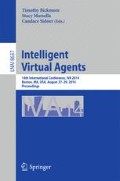Abstract
Laughter is an important social signal in human communication. This paper proposes a statistical framework for generating laughter upper body animations. These animations are driven by two types of input signals, namely the acoustic segmentation of laughter as pseudo-phoneme sequence and acoustic features. During the training step, our statistical framework learns the relationship between the laughter human motion and the input signals. During the synthesis step, our trained framework synthesizes automatically natural head and torso animations from the input signals. Objective and subjective evaluations were conducted to validate this framework. The results show that our proposed framework is capable of generating laughing upper body movements.
Access this chapter
Tax calculation will be finalised at checkout
Purchases are for personal use only
Preview
Unable to display preview. Download preview PDF.
References
Marsella, S., Xu, Y., Lhommet, M., Feng, A., Scherer, S., Shapiro, A.: Virtual character performance from speech. In: Proceedings of the 12th ACM SIGGRAPH/Eurographics Symposium on Computer Animation, pp. 25–35 (2013)
Cassell, J., Vilhjálmsson, H., Bickmore, T.: Beat: The behavior expression animation toolkit. In: Proceedings of SIGGRAPH, pp. 477–486 (2001)
Ruch, W., Kohler, G., Van Thriel, C.: Assessing the ‘humorous temperament’: Construction of the facet and standard trait forms of the state-trait-cheerfulness- inventory - stci. Humor: International Journal of Humor Research 9, 303–339 (1996)
Provine, R.R.: Laughter: A scientific investigation. Penguin Books Edn. (2001)
Huber, T., Ruch, W.: Laughter as a uniform category? A historic analysis of different types of laughter. In: Congress of the Swiss Society of Psychology (2007)
Ruch, W., Ekman, P.: The Expressive Pattern of Laughter. Emotion Qualia, and Consciousness, 426–443 (2001)
Darwin, C.: The expression of the emotions in man and animals. John Murray, London (1872)
de Melo, C.M., Kenny, P.G., Gratch, J.: Real-time expression of affect through respiration. Computer Animation and Virtual Worlds 21(3-4), 225–234 (2010)
Mancini, M., Varni, G., Glowinski, D., Volpe, G.: Computing and evaluating the body laughter index. In: Salah, A.A., Ruiz-del-Solar, J., Meriçli, Ç., Oudeyer, P.-Y. (eds.) HBU 2012. LNCS, vol. 7559, pp. 90–98. Springer, Heidelberg (2012)
McKeown, G., Curran, W., McLoughlin, C., Griffin, H.J., Bianchi-Berthouze, N.: Laughter induction techniques suitable for generating motion capture data of laughter associated body movements. In: FG, pp. 1–5 (2013)
Niewiadomski, R., Mancini, M., Baur, T., Varni, G., Griffin, H., Aung, M.S.H.: MMLI: Multimodal multiperson corpus of laughter in interaction. In: Salah, A.A., Hung, H., Aran, O., Gunes, H. (eds.) HBU 2013. LNCS, vol. 8212, pp. 184–195. Springer, Heidelberg (2013)
Fourati, N., Pelachaud, C.: Emilya: Emotional body expression in daily actions database. In: LREC 2014, The 9th International Conference on Language Resources and Evaluation, Reykjavik, Iceland, pp. 3486–3493 (2014)
Urbain, J., Çakmak, H., Dutoit, T.: Automatic phonetic transcription of laughter and its application to laughter synthesis. In: Proceedings of Affective Computing and Intelligent Interaction, pp. 153–158 (2013)
DiLorenzo, P.C., Zordan, V.B., Sanders, B.L.: Laughing out loud: control for modeling anatomically inspired laughter using audio. ACM Trans. Graph. 27(5), 125 (2008)
Wilson, A., Bobick, A.: Parametric hidden markov models for gesture recognition. IEEE Transactions on Pattern Analysis and Machine Intelligence 21(9), 884–900 (1999)
Brand, M.: Coupled hidden markov models for modeling interacting processes. Technical report (1997)
Sethares, W., Staley, T.: Periodicity transforms. IEEE Transactions on Signal Processing 47(11), 2953–2964 (1999)
Ding, Y., Prepin, K., Huang, J., Pelachaud, C., Artières, T.: Laughter animation synthesis. In: Proceedings of the 2014 International Conference on Autonomous Agents and Multi-Agent Systems, pp. 773–780 (2014)
Author information
Authors and Affiliations
Editor information
Editors and Affiliations
Rights and permissions
Copyright information
© 2014 Springer International Publishing Switzerland
About this paper
Cite this paper
Ding, Y., Huang, J., Fourati, N., Artières, T., Pelachaud, C. (2014). Upper Body Animation Synthesis for a Laughing Character. In: Bickmore, T., Marsella, S., Sidner, C. (eds) Intelligent Virtual Agents. IVA 2014. Lecture Notes in Computer Science(), vol 8637. Springer, Cham. https://doi.org/10.1007/978-3-319-09767-1_19
Download citation
DOI: https://doi.org/10.1007/978-3-319-09767-1_19
Publisher Name: Springer, Cham
Print ISBN: 978-3-319-09766-4
Online ISBN: 978-3-319-09767-1
eBook Packages: Computer ScienceComputer Science (R0)

